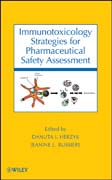
Immunotoxicology strategies for pharmaceutical safety assessment
Herzyk, Danuta J.
This core reference explains current strategies for immunotoxicology pharmaceutical safety assessments, which can reduce drug candidate attrition and streamline the development process. This guide thoroughly covers the testing neededto detect and characterize low-level immunotoxic hazards: 1) immunochemistry to address immunogenicity of biopharmaceuticals; 2) molecular immunology to evaluate immune dysregulation at the subcellular level; and 3) in vivo models ofimmune disorders to characterize potential impairment of host defense to infections, tumors, and autoimmune diseases. This is a key resource for practicingtoxicologists and scientists involved in drug development or regulation. INDICE: Introduction to Immunotoxicology (Jack H. Dean). Chapter 1: Current Regulatory Expectations for Immunotoxicity Evaluation of Pharmaceuticals (Kenneth L. Hastings). Chapter 2: Weight of Evidence Review: A New Strategy in Immunotoxicology. 2.1. Clinical Pathology as Crucial Insight into ImmunotoxicityTesting (Ellen Evans). 2.2. Histomorphology of the Immune System: A Basic Step in Assessing Immunotoxicity (Patrick Haley). 2.3. Need for Specialized Immunotoxicity Tests (Kazuchi Nakamura). 2.4. Specific Drug-Induced Immunotoxicity:Immune-Mediated Hemolytic Anemia (Raj Krishnaraj). Chapter 3: Nonclinical Core Immunotoxicity Testing in Drug Development. 3.1. Evaluation of Immunosuppression Potential by Immune Function Tests. 3.2. Evaluation of Drug Effects on Immune Cell Phenotypes (Laurie Iciek). Chapter 4: Extended Immunotoxicology Assessment: Ex Vivo Models. 4.1. Functional Cellular Responses and Cytokine Profiles (Elizabeth R. Gore). 4.2. Application of Flow Cytometry in Drug Development(Padma Narayanan, Nianyu Li, and Peter J. Bugelski). Chapter 5: Extended Immunotoxicology Assessment: In Vivo Models. 5.1. Animal Models of Host Resistance(Gary R. Burleson and Florence G. Burleson). 5.2. Approaches to Evaluation ofAutoimmunity (Danuta J. Herzyk). Chapter 6: Immunotoxicity Testing in Biopharmaceutical Development. 6.1. Differentiation between Desired Immunomodulation and Potential Immunotoxicity (Jeanine L. Bussiere and Barbara Mounho). 6.2. Relevant Immune Tests across Different Species and Surrogate Models (Jeanine L. Bussiere). 6.3. Anti-Drug Antibody Responses in Preclinical Studies and Their Implications (Barbara Mounho). Chapter 7: Development of Vaccines. 7.1. Pharmacological Immunogenicity and Adverse Responses to Vaccines (Mary Kate Hart, Mark Bolanowski and Robert V. House). 7.2. Immunotoxicological Concerns for Vaccines and Adjuvants (Catherine Kaplanski, Jose Lebron, Jayanthi Wolf and Brian Ledwith). Chapter 8: Testing for Drug Hypersensitivity. 8.1. Systemic Hypersensitivity (Raymond Pieters). 8.2. Nonclinical Models to Assess Respiratory Hypersensitivity Potential (Curtis C. Maier). Chapter 9: Testing for DevelopmentalImmunotoxicity. 9.1. Developmental Immunotoxicity in Rodents (Rodney R. Dietert and Leigh Ann Burns-Naas). 9.2. Developmental immunotoxicity in Non-Human Primates (Pauline L. Martin and Eberhard Buse). Chapter 10: New Methods in Assessing Immunomodulation, Immunotoxicity and Immunogenicity. 10.1. Alternative Animal Models for Immunomodulation and Immunotoxicity (Peter J. Bugelski). 10.2Animal Models for Preclinical Comparative Immunogenicity Testing (Daniel Wierda). 10.3. T-Cell Epitopes and Minimization of Immunogenicity (Harald Kropshoffer and Thomas Singer). Chapter 11: Bridging Immunotoxicology to Clinical DrugDevelopment (Ian Gourley and Jacques Descotes).
- ISBN: 978-0-470-12238-9
- Editorial: John Wiley & Sons
- Encuadernacion: Cartoné
- Páginas: 432
- Fecha Publicación: 19/09/2008
- Nº Volúmenes: 1
- Idioma: Inglés
